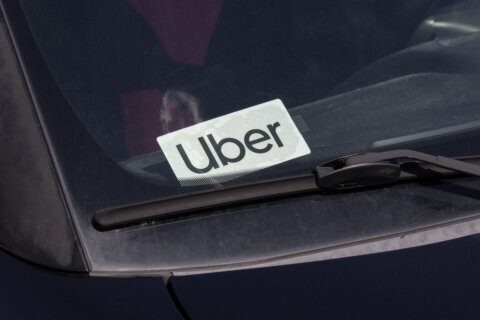More Americans are expected to vote by mail in the upcoming presidential election than in any previous U.S. election, due to changes made by states in response to the pandemic.
In fact, more voters are likely to cast their ballots by mail than go to the polls in person. But most voters have also not voted by mail before, and that can lead to some uncertainty about what’s ahead in the coming months.
It’s estimated more than 80% of voters will be eligible to get a ballot in the mail for the upcoming election, according to an analysis by The Washington Post.
If past voting patterns hold, close to 80 million mail ballots could be submitted across the country, which would more than double the number returned by mail in 2016.
Below are some common questions about voting by mail nationwide and specifically in the D.C. area.
- Q:
Which states allow voting by mail?
- A:
Virginia, Maryland and D.C. allow you to vote by mail without a specific reason or excuse. In the District, all registered voters will receive their mail ballot automatically. In Maryland, registered voters will receive an application automatically, but not a ballot. It must be postmarked by Election Day, Nov. 3.
In Virginia, a mail-in ballot must be requested by mail or online by Oct. 23, or by Oct. 31 in person.
Virginia and Maryland are among 34 states that allow any voter to vote by absentee ballot. Oregon was the first state to issue all ballots to voters by mail, starting in 2000. Nearly 100% of voting was done by mail in Oregon in the 2018 midterm elections.
Oregon, Washington state, Colorado, Utah and Arizona are the five states with the highest percentage of ballots submitted by mail.
- Q:
What’s the difference between mail-in voting and voting by absentee ballot?
- A:
The terms are often used interchangeably, but states make important distinctions. In the past, to vote by absentee ballot, a voter needed to provide a specific reason for not voting in person. (For example, military personnel have often voted absentee, owing to their deployments.) While most states now allow voters to mail in their ballots without an excuse or by citing the coronavirus, six states do not: Texas, Louisiana, Mississippi, Tennessee, South Carolina and Indiana all require a reason that goes beyond the virus to vote by absentee ballot.
- Q:
Is mail-in voting more likely to be linked to voter fraud?
- A:
President Trump, though he votes by mail in Florida, has repeatedly suggested that mail-in voting is subject to fraud. Election experts say that is not the case.
A Washington Post review of mail-in voting done in the 2016 and 2018 elections in Oregon, Colorado and Washington state found 372 possible cases of double voting or votes on behalf of dead people out of 14.6 million cast. That translates to a rate of 0.0025 percent. Republican and Democratic secretaries of state have said there is no evidence of widespread mail-in voter fraud in states that have allowed mail-in ballots for years.
- Q:
Will the U.S. Postal Service be able to deliver election mail on time?
- A:
The nation’s new Postmaster General, Louis DeJoy, has assured members of Congress that he will do everything he can to make sure mail-in ballots are delivered in a timely manner. But many congressional Democrats remain skeptical, given President Trump’s constant complaints about mail-in voting.
The House last month passed a bill to reverse changes DeJoy started to make at the U.S. Postal Service, but it will not be taken up by the Senate. DeJoy told a House committee that the Postal Service Board of Governors has established a bipartisan panel to oversee “processes in support of mail-in voting.”
Given the unprecedented number of mail-in ballots expected to be sent this fall, many election experts are cautioning voters to do their homework and make sure they send in votes as early as possible. More than 100,000 ballots mailed in during the 2018 midterm elections were never counted because they arrived late.
The Maryland Board of Elections last month moved the deadline for voters to return their ballot applications to Oct. 20, from Oct. 27, to make sure they get in on time.
- Q:
How old is mail-in voting?
- A:
Given all the attention to mail-in voting during this election year and the pandemic, it may seem like it’s a relatively new issue. But it actually goes back to the Civil War, when Northern states changed laws that had required in-person voting so soldiers who were deployed could vote. Not surprisingly, it became a partisan issue.
While today’s elections are as partisan as ever, recent studies indicate that mail-in voting does not significantly help one political party more than the other.
- Q:
What are the different terms for voting by mail?
- A:
D.C. uses the ballot terms “mail-in” and “absentee” interchangeably when referring to ballots that are mailed to you.
Maryland calls them mail-in ballots.
Virginia calls them absentee ballots.
- Q:
What do voters have to do to get a ballot mailed to them?
- A:
D.C.: If you are a registered voter, you do not have to apply for a ballot to be mailed to you. The District is automatically sending each voter a ballot directly to their mailbox.
If you want your ballot mailed somewhere other than your registered address, you need to apply at this link by Oct. 27.
Maryland: Applications for ballots have automatically been sent to the mailboxes of registered voters across the state. If you receive an application, you may either apply for the ballot online or fill out the physical application and mail it back.
Registered voters can also apply for a ballot by using this link.
Virginia: The state is not sending out ballots or ballot applications automatically, so you will need to apply for an absentee ballot if you want one mailed to you. You can do that by going to this link, where you can either apply online or print out the application and mail it in.
In a change from previous years, and due to recent changes to state law, any voter can now request an absentee ballot without having to provide an excuse as to why they cannot make it to the polls on Election Day.
- Q:
How much time do voters have to apply for a ballot?
- A:
D.C.: All voters will get mail-in ballots.
Maryland: The deadline to apply for a mail-in ballot to be mailed to you is Oct. 20.
Virginia: The deadline to apply for an absentee ballot to be mailed to you is Oct. 23.
- Q:
What should voters do after applying?
- A:
D.C.: Beginning in October, voters will be able to track the status of their mail-in ballots through this link on the Board of Elections website.
Maryland: Once you have applied for a ballot, you can visit this status link to check on the progress of your application and the ballot itself.
If you applied for a ballot online, but still received one of the automatically mailed ballot applications in your mailbox, don’t do anything with the mailed application: You should not apply twice. If you have any questions, go to the status link to check on your application and see where you are in the process.
Virginia: Once you have applied for a ballot, you can keep an eye on its progress by logging into the Board of Elections portal. When your application is approved, you’ll be able to see when your ballot was mailed to you, and after you send it back, you’ll be able to see when it’s received.
- Q:
When will the mail-in/absentee ballots be mailed to voters?
- A:
D.C.: Ballots will start being mailed to voters in the first week of October.
Maryland: Mail-in ballots will start being mailed to voters before the end of September, according to Maryland election officials.
Virginia: Absentee ballots will start being mailed to voters Sept. 18.
- Q:
What should be done with a completed ballot?
- A:
D.C.: Once you have your ballot, you should follow the included instructions and mail it back. Envelopes with prepaid postage are included.
In order for your vote to count, ballots must be mailed by Election Day, which is Nov. 3. That means if you mail your ballot on Nov. 3, you need to do so before the mail is picked up that day, but voters are strongly urged to not wait until the last minute. (Other options include hand-delivering your ballot to a ballot drop- off box, an early voting center or an Election Day vote center. D.C. has created a map showing where the drop boxes and vote centers are located).
Maryland: Once you have completed your ballot, you should follow the included instructions and mail it back. Envelopes are included with prepaid postage.
In order for your vote to count, ballots must be mailed by Election Day, which is Nov. 3. That means if you mail your ballot on Nov. 3, you need to do so before the mail is picked up that day, but voters are strongly urged to not wait until the last minute. (Other options include hand-delivering your ballot to a ballot drop off box, your local board of elections, an early voting center or an Election Day vote center.)
Virginia: Once you have completed your ballot, you should follow the included instructions and mail it back. While some localities will include prepaid postage with the envelopes, not all of them will, because it is not mandatory in Virginia.
In order for your vote to count, ballots must be mailed by Election Day, which is Nov. 3. That means if you mail your ballot that day, you need to do so before the mail is picked up, but voters are strongly urged to not wait until the last minute. (Another option is hand-delivering your ballot to your local elections office. Virginia is still working out the details of potential drop box locations).
- Q:
What if I’m not registered to vote?
- A:
D.C.: The process is slightly more complicated because in D.C. you cannot register online. However, this link takes you through the process step by step. You’ll need to submit your registration application by mail or email, and it must be received by Oct. 13. (After that, you’d need to register in person at an early-voting center or on Election Day.)
Maryland: You can register online through this link. The deadline to register online is Oct. 13. (After that, you’d need to register in person at an early-voting center or on Election Day).
Virginia: You can register online through this link. The deadline to register is Oct. 13. (That date is particularly important in Virginia, because the state does not allow same-day registration for people who vote on Election Day.)









